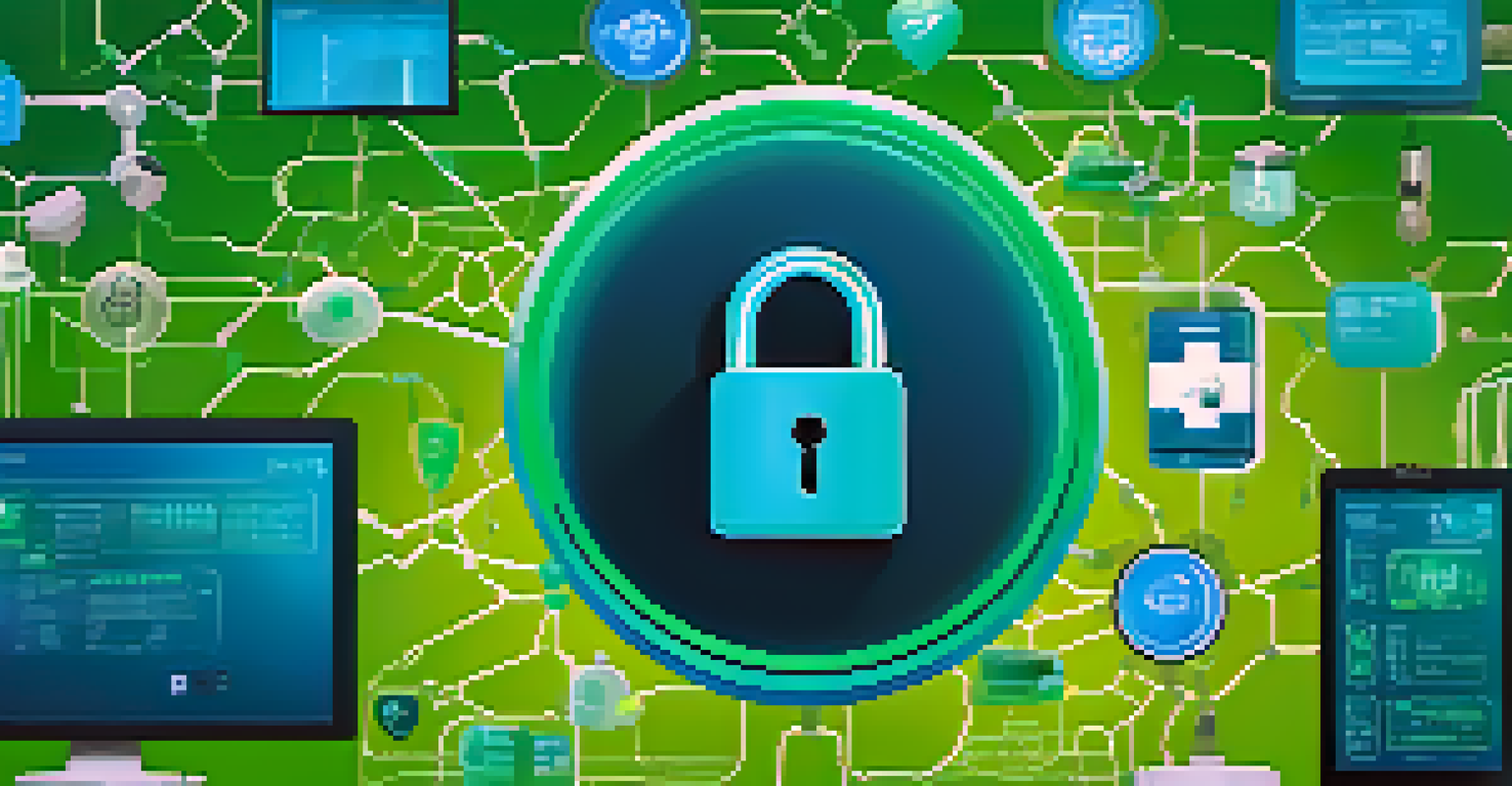Cybersecurity in Healthcare: Protecting Patient Data Integrity

Understanding Cybersecurity in Healthcare Settings
Cybersecurity in healthcare refers to the measures taken to protect sensitive patient information from unauthorized access, breaches, and other cyber threats. In an era where digital health records are commonplace, ensuring the security of this data is paramount. The stakes are high, as breaches can lead to the exposure of personal medical histories and financial information.
Cybersecurity is much more than a matter of IT. It is about protecting the lives of patients and the integrity of healthcare systems.
Healthcare organizations face unique challenges, including outdated technology, limited budgets, and a high volume of sensitive data. These factors make them attractive targets for cybercriminals, who often capitalize on vulnerabilities within the system. Thus, understanding the landscape of cybersecurity is essential for anyone involved in healthcare.
Moreover, the implications of poor cybersecurity can extend beyond individual patients. A breach can impact the entire healthcare ecosystem, leading to loss of trust, legal ramifications, and financial loss for organizations. Therefore, a comprehensive understanding of cybersecurity is the first step towards safeguarding patient data integrity.
The Importance of Patient Data Integrity
Patient data integrity refers to the accuracy, consistency, and reliability of patient data throughout its lifecycle. Maintaining this integrity is crucial, not just for compliance with regulations like HIPAA, but also for providing high-quality patient care. When healthcare professionals rely on accurate data, they can make informed decisions that lead to better health outcomes.

Inaccuracies in patient data can lead to misdiagnoses, inappropriate treatments, and even life-threatening situations. Imagine a scenario where a doctor prescribes medication based on incorrect allergy information; the consequences could be dire. Thus, ensuring that data remains intact and unaltered is vital for patient safety.
Cybersecurity Protects Patient Data
Robust cybersecurity measures are essential to safeguard sensitive patient information from unauthorized access and cyber threats.
Furthermore, data integrity impacts the operational efficiency of healthcare organizations. Errors in data can lead to increased costs and wasted resources, as staff may have to spend additional time correcting mistakes. Prioritizing data integrity ultimately fosters a culture of accountability and professionalism in healthcare settings.
Common Cybersecurity Threats in Healthcare
Healthcare systems face a variety of cyber threats, including phishing attacks, ransomware, and data breaches. Phishing attacks often target employees, tricking them into revealing sensitive information or downloading malicious software. These tactics can compromise entire systems if not addressed promptly.
In today's interconnected world, cybersecurity is an essential part of patient safety.
Ransomware, a particularly insidious form of malware, encrypts a victim's data and demands payment for its release. In healthcare, this can halt operations and put patient care at risk, making it a significant concern for organizations. The potential for financial loss and reputational damage drives the need for robust cybersecurity measures.
Data breaches can occur through various channels, including third-party vendors and insecure devices. With the increasing interconnectedness of healthcare technology, ensuring that all aspects of the system are secure is crucial. Understanding these threats is the first step towards developing effective prevention strategies.
Best Practices for Healthcare Cybersecurity
To mitigate cybersecurity risks, healthcare organizations should adopt a multi-layered approach that includes regular training for staff. Educating employees on recognizing phishing attempts and understanding safe data handling practices can significantly reduce the chances of a successful attack. After all, the human element is often the weakest link in cybersecurity.
Implementing strong access controls is another vital practice. By restricting access to sensitive data only to those who need it for their job, organizations can minimize the risk of unauthorized data exposure. Utilizing role-based access and regularly reviewing permissions can help maintain a secure environment.
Data Integrity is Crucial for Care
Maintaining the accuracy and reliability of patient data is vital for quality healthcare and avoiding potentially life-threatening errors.
Finally, staying up-to-date with the latest cybersecurity technologies and protocols is essential. Regular software updates and vulnerability assessments can help identify and patch security gaps before they are exploited. A proactive approach will not only protect patient data but also enhance the organization's overall resilience against cyber threats.
Regulatory Compliance and Cybersecurity
Compliance with regulations such as HIPAA (Health Insurance Portability and Accountability Act) is a cornerstone of cybersecurity in healthcare. These regulations set standards for protecting patient information and require organizations to implement specific security measures. Understanding these guidelines is crucial for any healthcare provider.
Failure to comply with these regulations can result in hefty fines and legal repercussions. For instance, a data breach that leads to a violation of HIPAA can cost organizations millions, not to mention the reputational damage. Therefore, organizations must prioritize compliance as part of their cybersecurity strategy.
Moreover, regular audits and assessments can help ensure that practices remain aligned with regulatory requirements. By embedding compliance into their cybersecurity framework, healthcare organizations can not only protect patient data but also foster trust with their patients and stakeholders.
The Role of Technology in Cybersecurity
Technology plays a pivotal role in enhancing cybersecurity measures within healthcare. Advanced tools such as firewalls, intrusion detection systems, and encryption technology help create a fortified digital environment. These technologies work together to monitor, detect, and respond to potential threats in real-time.
For example, encryption ensures that even if data is intercepted, it remains unreadable to unauthorized parties. This is particularly important for sensitive patient information, which must be protected at all costs. By leveraging technology, healthcare organizations can significantly reduce their vulnerability to cyberattacks.
Technology Enhances Cyber Defenses
Advanced technologies like encryption and AI play a key role in strengthening cybersecurity measures within healthcare organizations.
Additionally, artificial intelligence (AI) and machine learning are emerging as powerful allies in cybersecurity. These technologies can analyze vast amounts of data to identify unusual patterns and potential threats before they escalate. As the healthcare landscape continues to evolve, integrating advanced technologies will be essential for maintaining robust cybersecurity.
Future Trends in Healthcare Cybersecurity
As technology continues to advance, the landscape of cybersecurity in healthcare will also evolve. One trend to watch is the increasing adoption of telehealth, which has surged due to recent global events. While telehealth offers convenience, it also brings new cybersecurity challenges that organizations must address.
Another emerging trend is the use of blockchain technology for securing patient data. Blockchain can provide a transparent and tamper-proof method of recording health information, potentially revolutionizing how patient data is stored and accessed. This could enhance data integrity and security in unprecedented ways.

Finally, organizations must also focus on cultivating a culture of cybersecurity awareness. As cyber threats become more sophisticated, fostering an environment where employees are vigilant and informed will be crucial. The future of healthcare cybersecurity will rely on a combination of technology, compliance, and a proactive approach to education.